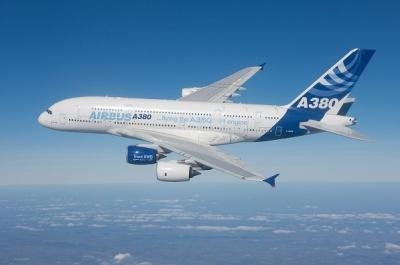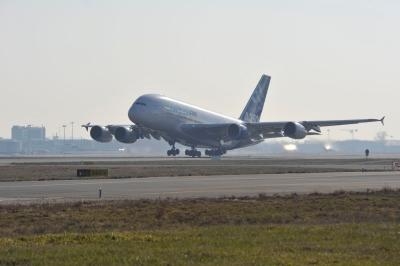Tue, Feb 21, 2012
Engine Flight-Test Campaign Underway One Year Ahead Of
Airplane’s First Flight
The A350 XWB’s new engine – the Rolls-Royce Trent
XWB – has successfully made its maiden flight aboard
Airbus’ dedicated A380 “Flying-Test-Bed”
aircraft. The aircraft took off from Airbus facilities in Toulouse
and performed a flight of more than five hours during which the
engine covered a wide range of power settings at altitudes up to
43,000ft. The aircraft handling qualities were evaluated from low
speeds to Mach 0.9. Rolls-Royce says the engine not only operated
flawlessly, but also demonstrated its new-generation fuel
efficiency and low noise.

The Trent XWB development engine, specially fitted with test
sensors to measure hundreds of parameters, was mounted on the
A380’s inner left engine pylon, replacing one of the
aircraft’s Trent 900 engines. The crew on board this first
flight were: Airbus Experimental test pilots Terry Lutz and Frank
Chapman; Experimental Test Flight Engineer Pascal Verneau; and
Flight Test Engineers Emanuele Costanzo and Tuan Do.
“The A350 XWB’s engine performed excellently during
its first flight-test, just as we expected,” said Charles
Champion, Executive Vice President of Engineering at Airbus.
“This is a promising start to the Trent XWB’s
flight-test program which will ensure a thorough real-life testing
of the engine, nacelle and its systems.” He adds: “This
will allow for a high level of powerplant integration, maturity and
reliability to be achieved by the time it flies on the first A350
XWB aircraft.”

Commencing around one year prior to the A350 XWB’s first
flight, this engine flight-test program is scheduled to accumulate
around 175 flight hours – some three times more airborne
flying hours than on previous programs. This will be accomplished
over a seven month period and will include hot weather as well as
icing condition testing campaigns. It will also test the advanced
nacelle and thrust reverser system provided by Goodrich.
The overall objective of these flight-tests is the early and
systematic validation of all performance aspects of the engine and
also the associated systems. In turn, this will contribute to
significantly ‘de-risking’ the A350 XWB’s
development well ahead of entry-into-service. The first results of
this flight-test campaign are expected this summer. (Photos
provided by Airbus)
More News
A Puff Of Smoke Came Out From The Top Of The Engine Cowling Followed By A Total Loss Of Engine Power On May 9, 2025, about 1020 mountain daylight time, an experimental amateur-buil>[...]
From 2022 (YouTube Edition): Jenny, I’ve Got Your Number... Among the magnificent antique aircraft on display at EAA’s AirVenture 2022 was a 1918 Curtiss Jenny painstak>[...]
Very High Frequency (VHF) The frequency band between 30 and 300 MHz. Portions of this band, 108 to 118 MHz, are used for certain NAVAIDs; 118 to 136 MHz are used for civil air/grou>[...]
“From approximately November 2021 through January 2022, Britton-Harr, acting on behalf of AeroVanti, entered into lease-purchase agreements for five Piaggio-manufactured airc>[...]
Microburst A small downburst with outbursts of damaging winds extending 2.5 miles or less. In spite of its small horizontal scale, an intense microburst could induce wind speeds as>[...]
 NTSB Prelim: Lee Aviation LLC JA30 SuperStol
NTSB Prelim: Lee Aviation LLC JA30 SuperStol Classic Aero-TV: Curtiss Jenny Build Wows AirVenture Crowds
Classic Aero-TV: Curtiss Jenny Build Wows AirVenture Crowds ANN's Daily Aero-Term (05.30.25): Very High Frequency (VHF)
ANN's Daily Aero-Term (05.30.25): Very High Frequency (VHF) Aero-News: Quote of the Day (05.30.25)
Aero-News: Quote of the Day (05.30.25) ANN's Daily Aero-Term (05.31.25): Microburst
ANN's Daily Aero-Term (05.31.25): Microburst




